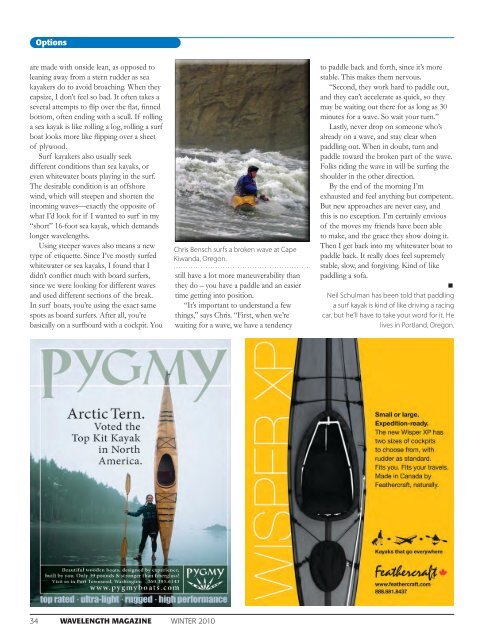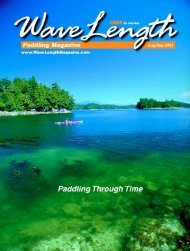Tricked out kayaks Hitting the water - Wavelength Paddling Magazine
Tricked out kayaks Hitting the water - Wavelength Paddling Magazine
Tricked out kayaks Hitting the water - Wavelength Paddling Magazine
You also want an ePaper? Increase the reach of your titles
YUMPU automatically turns print PDFs into web optimized ePapers that Google loves.
Options<br />
are made with onside lean, as opposed to<br />
leaning away from a stern rudder as sea<br />
kayakers do to avoid broaching. When <strong>the</strong>y<br />
capsize, I don’t feel so bad. It often takes a<br />
several attempts to flip over <strong>the</strong> flat, finned<br />
bottom, often ending with a scull. If rolling<br />
a sea kayak is like rolling a log, rolling a surf<br />
boat looks more like flipping over a sheet<br />
of plywood.<br />
Surf kayakers also usually seek<br />
different conditions than sea <strong>kayaks</strong>, or<br />
even white<strong>water</strong> boats playing in <strong>the</strong> surf.<br />
The desirable condition is an offshore<br />
wind, which will steepen and shorten <strong>the</strong><br />
incoming waves—exactly <strong>the</strong> opposite of<br />
what I’d look for if I wanted to surf in my<br />
“short” 16-foot sea kayak, which demands<br />
longer wavelengths.<br />
Using steeper waves also means a new<br />
type of etiquette. Since I’ve mostly surfed<br />
white<strong>water</strong> or sea <strong>kayaks</strong>, I found that I<br />
didn’t conflict much with board surfers,<br />
since we were looking for different waves<br />
and used different sections of <strong>the</strong> break.<br />
In surf boats, you’re using <strong>the</strong> exact same<br />
spots as board surfers. After all, you’re<br />
basically on a surfboard with a cockpit. You<br />
Chris Bensch surfs a broken wave at Cape<br />
Kiwanda, Oregon.<br />
still have a lot more maneuverability than<br />
<strong>the</strong>y do – you have a paddle and an easier<br />
time getting into position.<br />
“It’s important to understand a few<br />
things,” says Chris. “First, when we’re<br />
waiting for a wave, we have a tendency<br />
to paddle back and forth, since it’s more<br />
stable. This makes <strong>the</strong>m nervous.<br />
“Second, <strong>the</strong>y work hard to paddle <strong>out</strong>,<br />
and <strong>the</strong>y can’t accelerate as quick, so <strong>the</strong>y<br />
may be waiting <strong>out</strong> <strong>the</strong>re for as long as 30<br />
minutes for a wave. So wait your turn.”<br />
Lastly, never drop on someone who’s<br />
already on a wave, and stay clear when<br />
paddling <strong>out</strong>. When in doubt, turn and<br />
paddle toward <strong>the</strong> broken part of <strong>the</strong> wave.<br />
Folks riding <strong>the</strong> wave in will be surfing <strong>the</strong><br />
shoulder in <strong>the</strong> o<strong>the</strong>r direction.<br />
By <strong>the</strong> end of <strong>the</strong> morning I’m<br />
exhausted and feel anything but competent.<br />
But new approaches are never easy, and<br />
this is no exception. I’m certainly envious<br />
of <strong>the</strong> moves my friends have been able<br />
to make, and <strong>the</strong> grace <strong>the</strong>y show doing it.<br />
Then I get back into my white<strong>water</strong> boat to<br />
paddle back. It really does feel supremely<br />
stable, slow, and forgiving. Kind of like<br />
paddling a sofa.<br />
<<br />
Neil Schulman has been told that paddling<br />
a surf kayak is kind of like driving a racing<br />
car, but he’ll have to take your word for it. He<br />
lives in Portland, Oregon.<br />
34 WAVELENGTH MAGAZINE WINTER 2010

















